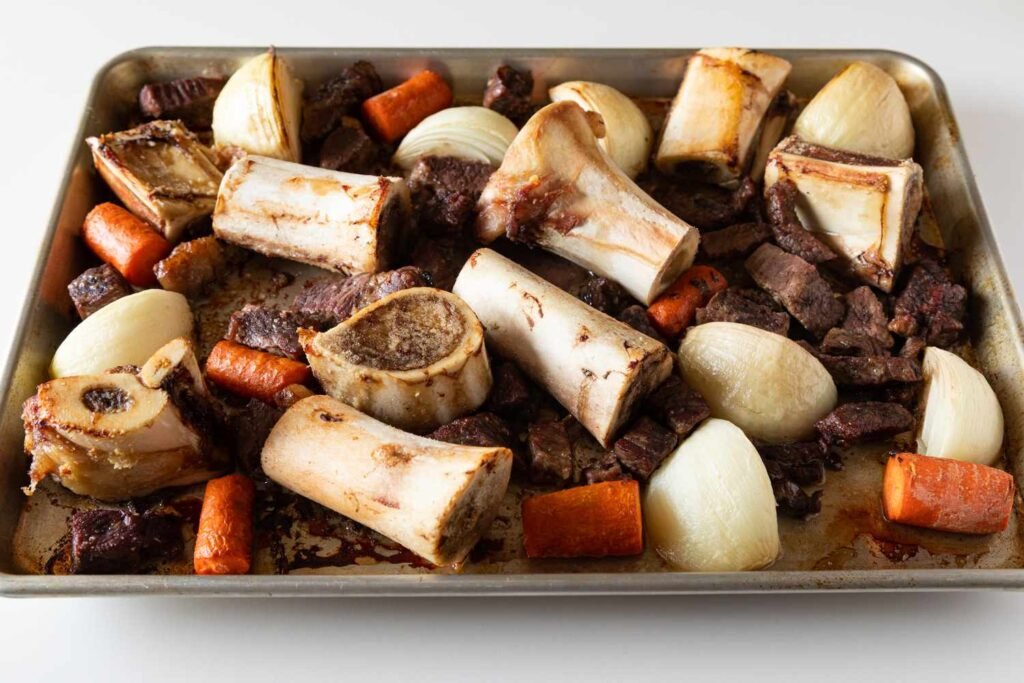Soup bones – those humble, often overlooked cuts that pack a flavorful punch. But what exactly can you do with them?
Soup bones are incredibly versatile in cooking. You can use them to make nutrient-rich broths, flavorful soups, savory sauces, and even treats for your furry friends. Simmering soup bones with vegetables, herbs, and spices unleashes their potential to add depth and complexity to various dishes, from Vietnamese pho to hearty stews.
I’ve got 7 mouthwatering recipes that showcase the many ways you can put soup bones to work in your kitchen. Your taste buds won’t know what hit ’em!
Are Soup Bones Healthy?
For centuries, soup bones have been a vital part of healthy cooking, providing a rich array of minerals and flavors that significantly enhance meals. They’re abundant in calcium, magnesium, and phosphorus, which are essential for the health of bones, and gelatin, which supports the health of joints.
These bones also contain marrow, which is rich in nutrients like vitamin A, vitamin K2, omega-3s, and omega-6s, crucial for the health of the heart and immune system.
Adding soup bones to your diet means you’re not just enriching your dishes; you’re also consuming a wide range of minerals and vitamins that contribute to overall health.
They’re a simple, yet profoundly effective way to add nutritional value to your cooking, allowing you to create dishes that are as nourishing as they’re flavorful.
1. Homemade Bone Broth

Creating your own homemade bone broth begins with simmering soup bones in water, adding a variety of vegetables and herbs to the mix.
This process turns these simple ingredients into a nutrient-rich and full-flavored base, ideal for enhancing the taste and nutritional value of soups, stews, and sauces.
Incorporating onions, carrots, and celery, along with a selection of herbs like thyme and bay leaves, adds depth to the broth’s flavor. The bones, through hours of simmering, release collagen, minerals, and amino acids, enriching the broth not just in taste but also in health benefits.
After straining, you’re left with a clear, rich broth that acts as a versatile component in various dishes, providing a comforting and deep essence. This straightforward method yields a profoundly rewarding culinary asset.
2. Slow Cooker Soup

After becoming adept at homemade bone broth, you’ll see that preparing a slow cooker soup with bones, vegetables, and meat offers convenience without compromising on taste or health benefits.
This technique turns basic components into a rich, savory soup that is both enriching and fulfilling. Simply prepare it in the morning, and by the time dinner rolls around, a comforting meal awaits to warm you.
| Ingredient | Suggestion |
|---|---|
| Soup Bones | Beef, chicken, or pork |
| Vegetables | Carrots, celery, onions |
| Liquid | Water or broth |
| Cooking Time | 6-8 hours on low |
This method allows the bones to release their marrow and minerals, enhancing the broth with richness and complexity. The gradual blending of flavors yields a comforting bowl of soup ideal for any cold evening.
3. Pho Broth

At the center of the Vietnamese culinary tradition lies the pivotal element: the beef soup bones cook into a deeply flavored, aromatic broth for pho by simmering the bones together with a whole host of spices, including cinnamon, star anise, and cloves
This process, though seemingly simple, fills your kitchen with an enticing aroma, heralding an exquisite gastronomic experience.
Start by preparing the bones to unlock their rich, intricate flavors. Next, in a substantial pot, merge these bones with your chosen spices, filling the pot with water.
The real magic unfolds as this blend gently simmers, allowing the spices’ warmth to fuse with the richness of the bones, resulting in a broth that’s both comforting and rejuvenating.
After straining, what remains is an ideal foundation for authentic pho, ready to be embellished with noodles, herbs, and slices of tender meat.
4. Ramen Broth

In place of the aromatic spices of Vietnamese pho, pork soup bones make a succulent beginning for a rich and creamy broth that is flavored with ginger, garlic, and soy sauce.
If you had your way, then just imagine your kitchen slowly filling up with steam from the simmering broth, like yet another signal that a tasty dinner is in the making.
Here’s what you’ll need to create this culinary masterpiece:
- Pork Soup Bones: The core of your broth, simmered to draw out their rich flavors.
- Ginger and Garlic: Add complexity and warmth with their powerful flavors.
- Soy Sauce: Brings an umami depth that perfectly complements the broth.
- Noodles, Vegetables, Soft-Boiled Eggs: Transform your broth into a complete, soul-satisfying ramen dish.
This ramen broth invites you to experiment with flavors and textures, offering a new experience with every bite.
5. Gravy and Sauces

Roasting soup bones until they’re beautifully browned is a method that turns them into a rich base for exquisite gravies and sauces. Begin by warming your oven and placing the bones on a tray.
As they cook, their flavors intensify, promising an unmatched depth to your culinary creations. Once they achieve a golden brown hue, move them to a pot and cover with water or broth.
The process of simmering extracts every bit of flavor, resulting in a base that’s perfect for thickening into gravies or enhancing sauces with its meaty essence. Taking your time during this step is crucial; a slow and gentle simmer is the best way to extract flavors.
After straining the liquid, you’re left with a versatile base, ready to transform your meals with its profound, meaty essence.
6. Vegetable Stock

To create a rich, vegetarian-friendly stock, simmer a mixture of vegetable scraps and boneless soup bones in water. This simple process transforms basic ingredients into a base full of flavor and nutrients for your dishes. Here’s a glimpse into this culinary magic:
- Golden onions and carrots caramelize slowly, releasing their sweet flavors.
- Celery leaves and parsley stems add fresh, green notes.
- Mushroom trimmings contribute an earthy foundation.
- Boneless soup bones provide body and richness without meat.
As these elements come together, they produce a stock that isn’t merely a liquid, but a foundation for your culinary creations. It’s nutritious, flavorful, and completely satisfying.
7. Dog Treats

After you have used your soup bones to enhance the flavor of broth, consider reusing these bones as nutritious and enjoyable snacks for your dog, ensuring they’re suitably large to prevent any choking risks. This approach reduces waste while offering your pet a treat that’s both tasty and healthful.
Bones are a source of essential minerals and support dental hygiene through the act of chewing. It’s crucial to watch over your dog while they enjoy this snack to ensure their safety.
Choosing bones that can’t be swallowed whole reduces the risk of choking, making snack time a pleasant and stress-free experience for you and your canine companion.
How Many Times Can You Use Soup Bones?
You might be curious about how many times soup bones can be re-utilized in your cooking ventures to maximize flavor and nutritional benefits. Here’s what you need to know:
- First Use: The initial use of soup bones yields the most potent flavors and nutrients.
- Second Use: They can be employed once more, although the taste will be milder and the broth less robust.
- Third Use: At this stage, the bones have almost exhausted their essence, producing a very delicate broth, perfect for cooking grains.
- Beyond Three Uses: It’s generally advised against, as the bones have likely depleted their culinary value.
For optimal outcomes, think about your objectives—whether you’re aiming for rich broths or subtle, nutritious infusions—and make your choice.
Do Soup Bones Have Collagen?

Soup bones, abundant in collagen, become gelatin-like when cooked slowly, improving the texture and health advantages of your broths. Adding these bones to your homemade soup or broth not only infuses it with flavor but also with a significant amount of collagen.
This protein is essential for giving broths a rich, satisfying texture and is known for its potential benefits, such as aiding in joint health and improving skin elasticity.
Through the slow cooking process, collagen is extracted from the bones into the broth, turning it into a nutrient-rich potion.
This method lends your soups a richness and complexity, transforming them into not only a comfort food but also a beneficial meal for your health.



